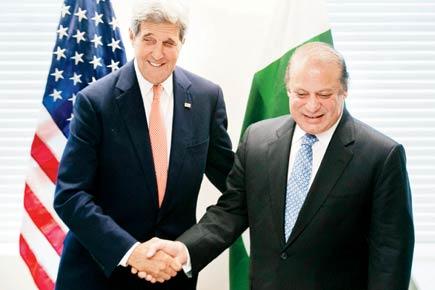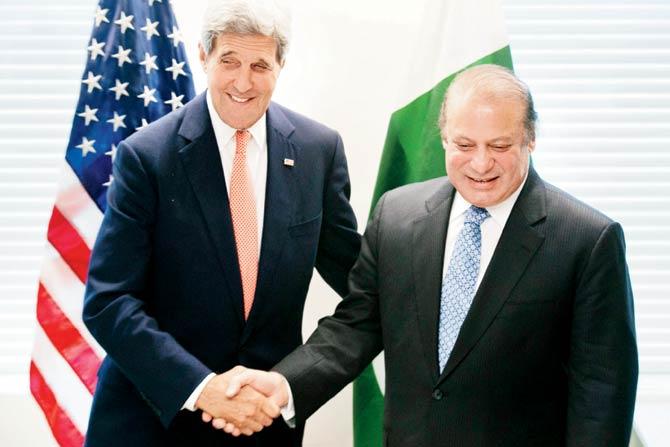The report that the US was contemplating a nuclear deal with Pakistan, similar to the one it has with India, is yet another confirmation of the salience of geopolitics in international relations

 The report that the US was contemplating a nuclear deal with Pakistan, similar to the one it has with India, is yet another confirmation of the salience of geopolitics in international relations.
The report that the US was contemplating a nuclear deal with Pakistan, similar to the one it has with India, is yet another confirmation of the salience of geopolitics in international relations.
ADVERTISEMENT
America’s relations with Pakistan have had their decadal ups and downs. Not surprisingly, these have often mirrored the geopolitical interests of Washington. In the 1950s, it was the contest with the Soviet Union, and so Pakistan, located strategically in what was called the “northern tier”, was privileged over the much larger India, which wanted to avoid getting entangled in superpower competition.

US Secretary of State John Kerry (left) with Pakistan PM Nawaz Sharif at the United Nations headquarters on September 27. Emerging Sino-Pak alliance is one of the factors that has motivated the US to offer Islamabad the hand of friendship, which Pak has been seeking from the time of the Indo-US nuclear deal. Pic/AFP
Of course, as is well known, Pakistan was not motivated by any anti-communist ideology, but its own contest with India. This was evident as early as 1962, when it befriended communist China, because it offered a more consistent anti-Indian stage.
After a hiatus, in which the US was preoccupied by the Vietnam war, Pakistan’s importance was recognised by Henry Kissinger and Richard Nixon as a key to their “China pivot” aimed at outflanking the Soviets. The monstrous price for this was the support that the Kissinger-Nixon duo gave to Islamabad in prosecuting its genocidal war against the liberation movement in Bangladesh.
A decade later came the final contest with the Soviet Union and this time Pakistan was not wanting. It provided Washington the platform needed to bleed the Soviets, never mind the price for that — the curse of jihadism, with which we are still grappling. The bonus for Islamabad was that Washington turned a Nelson’s eye on Pakistan’s nuclear weapons programme.
Roughly, a decade later, the Americans were back, this time to fight the jihadists their earlier intervention had bred. The price this time has been in dollars — the $31 billion that has come by way of Islamabad as military and economic aid between 2002-2015 — and in the blood and treasure that the US has expended in Afghanistan, in considerable measure because of Pakistani duplicity.
So, what motivates the US this time to offer Islamabad the hand of friendship ? No doubt, geopolitical considerations relating to jihadism and Afghanistan are important elements. But, the emerging Sino-Pak alliance is an added factor. Inter-mixed are legacy concerns of the Obama administration which has ambitiously articulated a vision of a nuclear weapons free world.
From the time of the Indo-US nuclear deal, Pakistan has sought a similar arrangement for itself. It is using its time tested tactic of holding a gun to its own. head to achieve its goal. First, it has blocked all efforts to finalise the Fissile Material Cut-off Treaty (FMCT). Second, it sharply ramped up its production of nuclear weapons, abandoning all pretenses of maintaining a “credible minimum deterrence” and moving to what it calls “full spectrum” deterrence.
However, given Islamabad’s terrible proliferation record, most experts initially laughed off the possibility. At the time, many of us argued that the Indo-US nuclear deal arose out of the desire of the US to build closer, strategic ties with India as a means of offsetting China’s rise. Now, it would appear that the American motives are more complex.
Islamabad has been insistently pushing for a nuclear deal, most recently in the seventh round of the US-Pakistan Security, Strategic Stability, and Nonproliferation (SSS&NP) working group in June. The press release, following the talks held under the auspices of the US-Pakistan strategic dialogue, says it all, “The US delegation welcomed Pakistan’s efforts to harmonise its strategic trade controls with those of the Nuclear Suppliers Group and other multilateral export control regimes. Both sides emphasised the desirability of continued outreach to integrate Pakistan into the international nonproliferation regime. Pakistan stressed the need for access to peaceful nuclear technology as a socio-economic imperative.”
A Pakistani nuclear deal would suggest that the US is determined, as it has always been to maintain good ties with both India and Pakistan. Those in India, who expected that Washington’s unhappiness with Islamabad would result in undivided attention to New Delhi, will be disappointed. But, the US is following the logic of its geopolitical interests.
So, sooner, rather than later, Pakistan will get what it wants. India’s best option is to let things ride. Opposing the deal, for the sake of opposing it, is a fool’s errand not unlike the hysteria that India unleashed when the US decided to supply F-16s to Pakistan in 1981-82.
What we need to do is to learn yet another lesson on the relentlessness with which big powers pursue their interests, and move ahead on the project that will give us geopolitical heft in Asia: The economic transformation that will enable us to straddle the region from the Middle East to South-East Asia.
The writer is a Distinguished Fellow, Observer Research Foundation, New Delhi
 Subscribe today by clicking the link and stay updated with the latest news!" Click here!
Subscribe today by clicking the link and stay updated with the latest news!" Click here!







